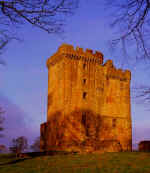|
This
surname, possibly the most celebrated in the history of Scotland, is of Norman territorial
origin, from the Chateau d'Adam at Brix situated between Cherbourg and Valognes. The ruins
of this 11th century fortress built by, and named after, Adam de Brus, can still be seen.
The first Robert de Brus recorded in Britain accompanied the army of William the Conqueror
in 1066; he died circa 1094. This Robert de Brus is claimed as the progenitor of the clan
although it was his son, also called Robert de Brus, but known as Robert le Meschin, or
"the Cadet", who was the first of the family connected with Scotland. When the
most powerful baron in England, and youngest son of Queen Margaret, went to Scotland to
become King David I in 1124, he was accompanied by, amongst others, Robert the Cadet.
David I granted him the lands of Annandale which he renounced to his second son, yet again
named Robert, before the Battle of the Standard in 1138. Robert, fourth Lord Annandale,
married a niece of William the Lion, which formed the basis of subsequent claims of the
Bruces to the throne of Scotland. This was realised in Robert, the seventh Lord Annandale,
second Earl of Carrick, who was born in 1274 and crowned King at Scone in 1306. His
celebrated victory against the English at Bannockburn in 1314 gained the independence of
Scotland which was ratified by the Treaty of Northampton in 1328. He died in 1329 and was
buried at Dunfermline although his heart, having first been carried to the Crusades, was
brought back to Scotland and buried at Melrose Abbey. David II, King Robert's only son,
died childless and the Royal Line was taken up by the Stewart descendants of Lady Marjory
Bruce. In 1334, Thomas Bruce, whose relationship to David II is uncertain, organised a
rising against the English supporters of Balliol who had plaqued the reign of David II.
For this service he was awarded the crown lands in Clackmannan and from this branch are
descended the Earls of Elgin. The present Earl is Chief of the Bruces, who are not,
strictly speaking, a clan - rather they are a powerful lowland family.

Clackmannan Tower, Clackmannan
The town of Clackmannan has a long association with the
Bruce family and this keep was the home of Robert the Bruce for a while. It was built
originally in the 14th century but substantially altered over the next three hundred
years. |

